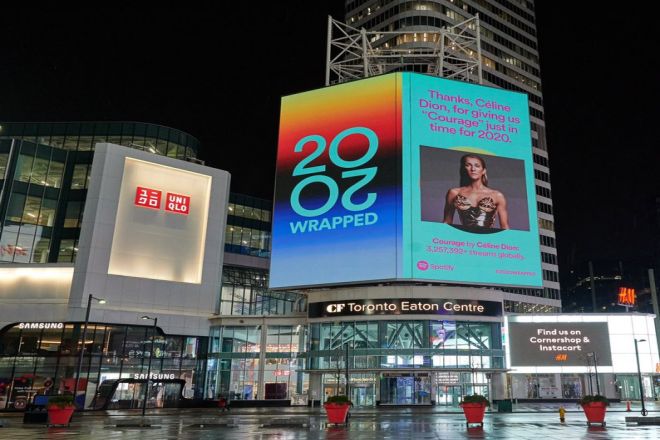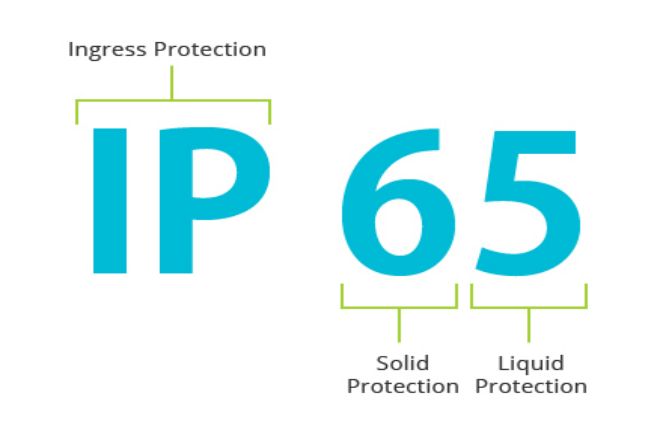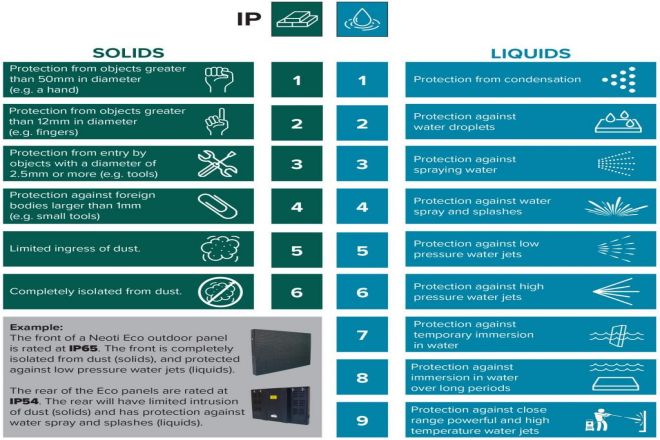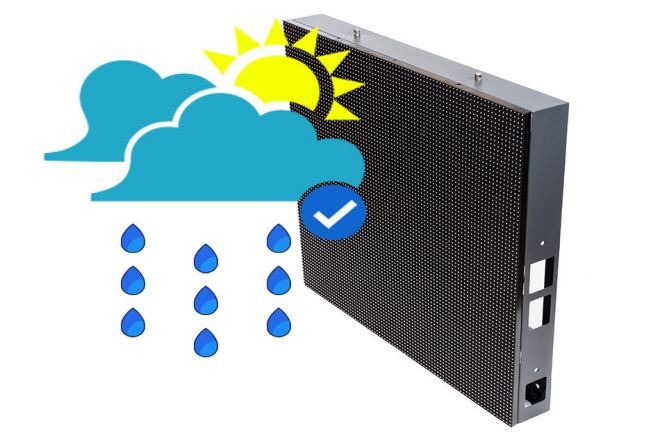Introduction

In the process of using the LED display, we should not only pay attention to its display effect and functionality but also pay attention to its protection level to ensure the stable operation of the display screen in various environments and ensure its safety.
Then, this article will discuss in detail the concept and standard of the protection level of LED display screens and its consideration in practical application. Let’s take a look.
1. What is the IP level of the LED display?

The IP level of the LED display, the Ingress Protection level, is a standard that indicates the protection ability of electronic devices against solid substances and liquids.
It classifies full-color LED displays according to the characteristics of dustproof, anti-fouling, waterproof, and moisture-proof, which is drafted by the International Electrotechnical Commission (IEC) and formulated by the International Organization for Standardization (ISO). The IP level consists of two numbers:
The first number represents the dust resistance level, ranging from 0 (unprotected) to 6 (completely prevent dust from entering);
The second number represents the waterproof level, ranging from 0 (unprotected) to 8 (soaking for a long time under a certain pressure).
Why is IP level important for LED display? The reasons are as follows:
First of all, the IP level is directly related to the stability and reliability of the LED display. The high dustproof display can effectively prevent the intrusion of dust and other solid substances, thus ensuring that the electronic components and lines inside the screen are not damaged.
Similarly, the high-waterproof display can work normally in bad weather conditions to avoid short circuits or damage caused by rain or humid environments.
Secondly, the IP rating has an important impact on the service life of the LED display. A display screen with good dustproof and waterproof performance can resist various adverse environmental factors and reduce the possibility of failure, thus extending its service life.
In addition, the IP level is more important for LED displays for outdoor use. Outdoor environments usually face more challenges, such as wind and rain, sand and dust. An outdoor LED display with a high IP level can maintain a stable display effect under these harsh conditions to ensure the accurate transmission of information.
Therefore, it is very important to know its IP level when choosing an LED display. Choosing the appropriate IP level according to the use environment and needs can ensure the performance and life of the display while reducing maintenance costs and risks.
2. What is the difference between the IP65, IP66, and IP67 protection levels of LED displays?
There are indeed significant differences in the details of the IP65, IP66, and IP67 protection levels of the LED display, which are mainly reflected in the protection ability of the external environment and mechanical impact.
- IP65 protection level:
This level indicates that the LED display has a high degree of dust resistance, that is, it can completely prevent dust from entering the device. At the same time, it also has quite good waterproof ability, which can resist water splashing from any direction and prevent it from causing damage to the equipment.
However, the IP65 protection level does not prevent the liquid from penetrating from the bottom of the device, nor does it ensure that the equipment works normally when it is completely flooded. Therefore, when used outdoors, the IP65-level display can cope with ordinary rainy weather, but it may not work properly in extreme flooding environments.
- IP66 protection level:
Compared with IP65, IP66 has no difference in dust resistance, which can completely prevent dust from entering. However, in terms of waterproof performance, IP66 has been significantly improved. It can not only resist water splashing from any direction but also prevent the equipment from being directly impacted by strong currents or rainstorms.
More importantly, the IP66 protection level display can work normally after a short period of immersion at a certain depth, which makes it more adaptable in the outdoor environment.
- IP67 protection level:
This level has reached a higher standard in terms of dustproof and waterproof performance. It can also completely prevent dust from entering and splashing water from any direction.
But what’s better is that the IP67 protection level display can continue to work normally at a depth of 1 meter for 1 hour, which allows it to maintain stable operation in harsh environments such as underwater work or rainstorms.
In addition, IP67 can also prevent equipment from being damaged under strong mechanical shocks, which further enhances its durability in complex environments.
In addition to waterproof and dustproof performance, these three levels of display screens may also be different in other aspects, such as heat dissipation performance, visual effects, etc. Therefore, when choosing the LED display, in addition to considering the protection level, it is also necessary to conduct a comprehensive evaluation according to the specific use environment and needs.
3. How does the IP rating affect the durability and applicability of the outdoor LED display?

IP level plays a very important role in the durability and applicability of outdoor LED displays. In short, the IP rating is like putting a layer of “protective clothing” on the display screen to help it resist dust and water outside. In this way, the display can work better and last longer.
IP rating has a significant impact on the durability and applicability of outdoor LED displays. Specifically, the different combinations of IP grades reflect the dustproof and waterproof performance of the display, which directly determines the stability and service life of the display in an outdoor environment.
First of all, from the perspective of dustproof, the higher the first number in the IP level, the stronger the display’s protection against solid particles.
For outdoor environments, especially where there are more particles such as sand, dust, and pollen, the high dustproof display screen can effectively prevent these particles from entering the interior of the display screen and avoid damage to internal electronic components. This can not only improve the durability of the display and reduce the failure rate but also prolong its service life.
Secondly, waterproof performance is also an important factor that outdoor LED displays cannot be ignored. The second number in the IP rating represents the waterproof ability of the display. In an outdoor environment, the display screen may encounter rain, snow, and even other liquid splashes.
A display with a high waterproof level can effectively resist the intrusion of these liquids and ensure that it can still work normally in a humid or underwater environment. This is particularly important for outdoor billboards, stadium display screens, and other application scenarios.
In addition, the IP level also affects the applicability of outdoor LED displays. Different use scenarios have different protection requirements for the display. For example, coastal areas may need to consider the protection ability of the display to salt spray, while high mountain areas need to consider the adaptability of the display to low-temperature environments.
Choosing the appropriate IP level can ensure that the display can work normally in different environments and meet the needs of various application scenarios.
4. Can the LED display with a low protection level be used indoors?
The LED display with a lower protection level can be used indoors.
Because the indoor environment is usually relatively stable, and there are no bad weather conditions and mechanical shocks like outdoors, the low dustproof and waterproof display screen is enough to meet the needs of indoor use.
When selecting the LED display, the appropriate IP protection level should be determined according to the specific use environment and needs. For indoor environments, generally speaking, it is not necessary to consider waterproof and dustproof levels like outdoors, so choosing a display screen with a low protection level is both economical and practical.
However, please note that even in the indoor environment, there may be dust, humidity, and other problems, so it is still necessary to choose a display suitable for the indoor environment and clean and maintain it regularly to ensure its normal operation and extend its service life.
In addition, in addition to the protection level, when selecting the LED display, it should also consider its brightness, resolution, contrast, and other performance indicators, as well as power consumption, heat dissipation, and other use characteristics to ensure that the selected display can meet the actual application needs.
At the same time, in order to ensure the safety and stability of the display screen, it is recommended that you purchase from formal channels and choose products from well-known brands to obtain better quality assurance and technical support.
5. If you want to use an LED display in a place where the weather conditions are not good all year round, how do you choose the IP protection level?

For LED displays used in harsh weather conditions, there are indeed some specific IP protection level suggestions. Considering the various challenges that the outdoor environment may face, such as strong winds, rainstorms, thunder and lightning, and temperature changes, the choice of the protection level of the display screen is particularly important.
First of all, for waterproof performance, outdoor LED displays are usually recommended to reach an IP65 or higher protection level. This means that the display can effectively prevent dust from entering and can resist water splashing from any direction, even short-term immersion.
In a rainstorm or high-humidity environment, this waterproof level can ensure that the display screen works properly and avoids short circuits or damage.
Secondly, for wind resistance, although there is no direct IP level corresponding to it, the impact of strong wind must be taken into account when designing and installing LED displays.
Especially for display screens installed in high-rise buildings or open areas, it is necessary to adopt a strong steel structure and a suitable installation method to ensure that it can withstand the impact of strong winds and prevent falling off or damage.
In addition, lightning protection does not directly involve the IP level, but it is also a problem that cannot be ignored. In the summer and autumn of Duolei, the LED display must take lightning protection measures, including setting up lightning rods, lightning protection of power supply and signal lines, etc., to ensure the safe use of the display screen in lightning weather.
Conclusion
Through studying this article, I believe readers can have a deeper understanding of the protection level of LED displays. They can pay more attention to their protective performance when selecting and using LED displays to ensure the smooth progress of activities.
Finally, if you want to know more about the LED display, please get in touch with us.
